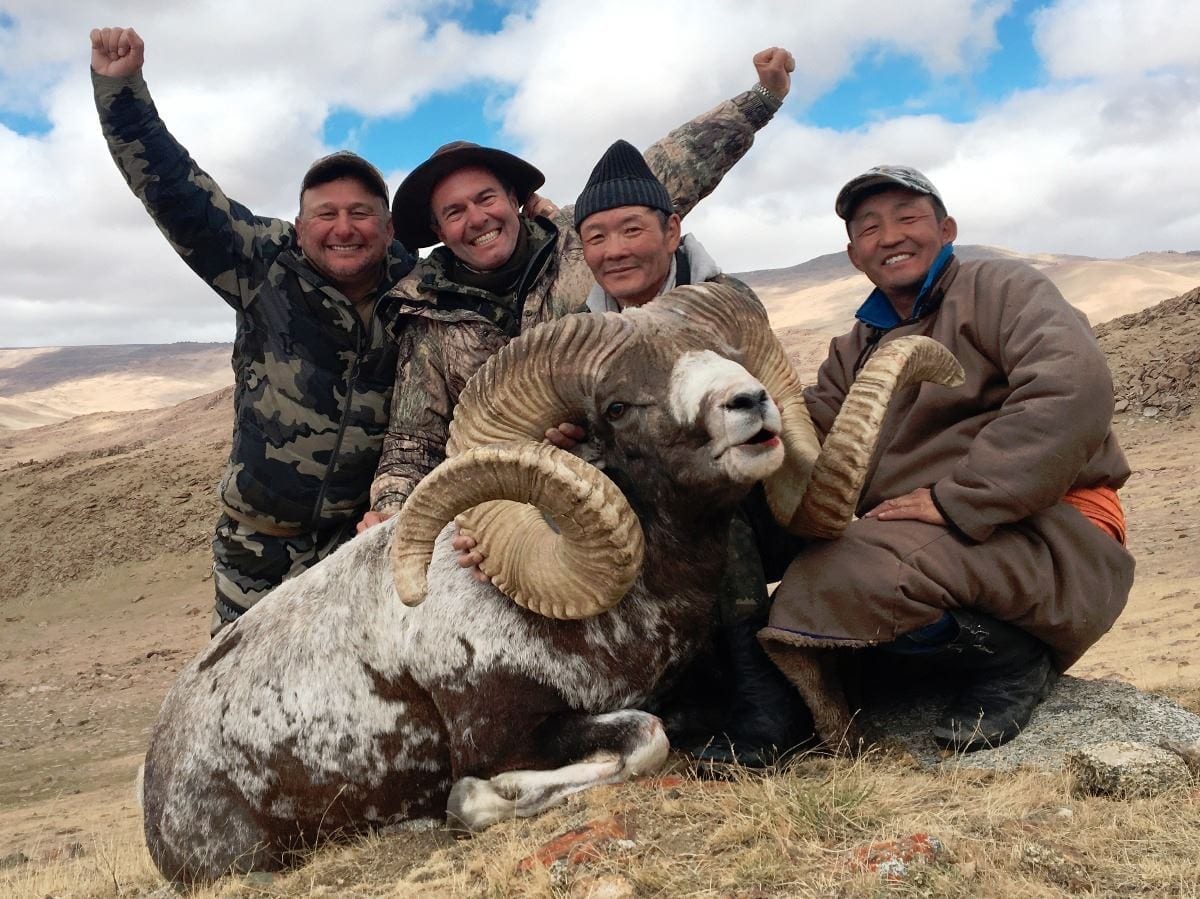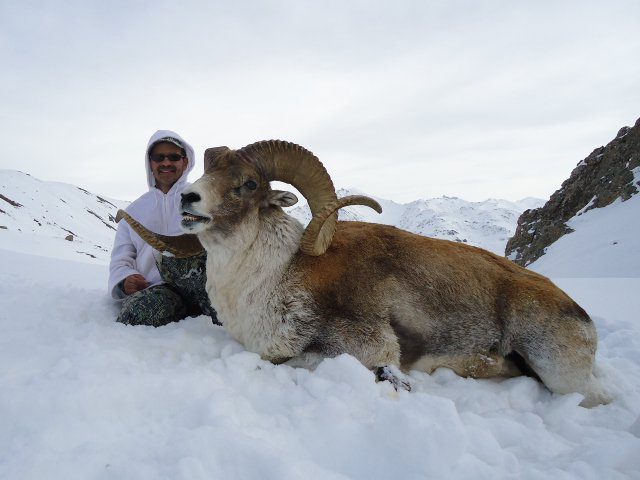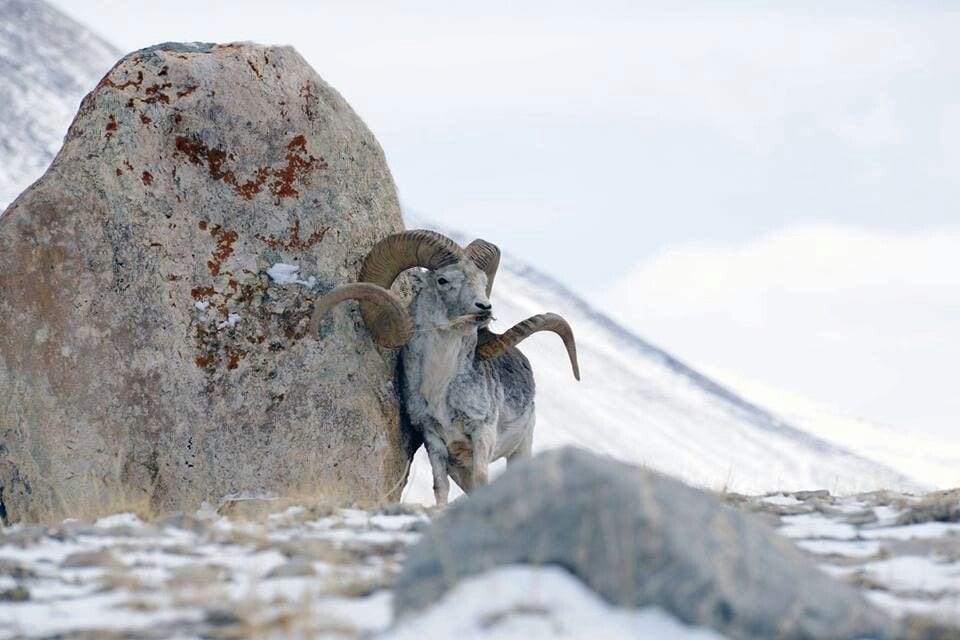The argali (Ovis ammon) stands as the grandest of wild sheep, encompassing the largest species within this family. In appearance, an argali boasts a coat of light brown hue, accompanied by legs of pristine white and a distinct white patch adorning its rump. Notably, both male and female argalis possess horns, yet those adorning the males are strikingly larger and more imposing, constituting up to a remarkable 13 percent of their overall body mass. Furthermore, an additional distinction adorns the male argali—a ring of ivory hair encircles its neck while a remarkable crest embellishes its dorsal line, further amplifying its already impressive countenance. All subspecies of argali sheep are native to the highlands of central Asia,
It was William of Rubruck, a monk dispatched to Mongolia, who became the first European to provide an account of the argali back in 1253. Describing them as creatures bearing the physique of bears merged with the magnificent horns of rams, William’s depiction initially met with skepticism among Europeans. It was not until 1838 when John Wood dispatched a collection of horns from Afghanistan to the esteemed Royal Society in England that doubt was dispelled, finally acknowledging the existence of a sheep surpassing the magnitude of a cow.
Nine subspecies of argali are recognized.
- Altai argali, O. a. ammon
- Karaganda argali, O. a. collium
- Gobi argali, O. a. darwini
- Tibetan argali, O. a. hodgsoni
- North China argali, O. a. jubata
- Tian Shan argali, O. a. karelini
- Kara Tau argali, O. a. nigrimontana
- Marco Polo argali, O. a. polii
- Severtzov argali, O. a. severtzovi
Argali Range
Within the realm of central Asia, the argali finds its habitat, spanning from the western reaches of central Kazakhstan to the eastern bounds of China’s Shanxi Province, and from the northern foothills of the Altai Mountains to the southern reaches of the Himalayas. These majestic creatures primarily inhabit steep slopes situated at elevations exceeding 12,000 feet. Remarkably, adult males demonstrate a preference for optimal vegetative habitats, which tend to be more exposed compared to the territories favored by younger rams and ewes. As the summer months usher in an abundance of sustenance, the argali, as one collective entity, ascends to greater altitudes.
As grazers, argalis engage in their daily activities during daylight hours.
Frequently congregating in herds consisting of 2 to 100 individuals, they exhibit a pattern of gender segregation, save for the fleeting mating season. Remarkably social creatures, argalis engage with one another in a calm and non-aggressive manner, with herd members dutifully trailing behind their peers. Seeking connections, these creatures often initiate contact with fellow argalis, displaying a unique camaraderie.
It is worth noting that argalis seldom employ their formidable horns for defense against predators. Instead, they prioritize evasion and swift flight as their primary strategies when confronted by looming threats. When struck by fear, an isolated argali may choose to remain motionless until the danger has passed—a striking contrast to their behavior when part of a herd, where a mere alarm sets them into motion, prompting immediate flight.
Mating Habits
Argalis embody a polygynandrous mating system, where both males and females engage in multiple partnerships. Dominant males mate with numerous females, overseeing their harem during the breeding season. Female argalis, presented with an opportunity, may choose to mate with multiple males, a circumstance that arises when shifts in male dominance occur or when a female departs to join another herd.
The ritual of mating transpires during the autumn and early winter seasons, culminating in a gestation period spanning 150 to 180 days. A female argali brings forth one, occasionally two, precocial lambs. In preparation for birth, females distance themselves from their herds, remaining separate for several days. During this period, the newborn lamb remains still, grazing only as the mother attends to her sustenance.
Weaning occurs around the four-month mark, at which point the lamb typically integrates into a social group comprising fellow young individuals. Females attain sexual maturity by the age of two, while their male counterparts reach this milestone by the age of five.
Huntable Subspecies of Argali
Altai Argali

Currently, the only place that you can hunt Altai argali is in Mongolia, and fewer than ten tags are issued each year. This is a highly coveted species, and if you are interested, be ready to book years in advance.The Altai Argali (Ovis ammon ammon), is the most impressive sheep in the world. Found in Asia, they have massive horns with the “argali flair”, ranging from 52 to over 60 inches long, with 18 to 21 inch bases. Trophy quality has steadily improved over the years due to management and conservation efforts from hunting groups.
Gobi Argali
The Gobi Argali (Ovis ammon darwin), is found, as the name suggests in the Gobi Desert of Mongolia, and small herds are also found in northern China. They look very similar to the Altai Argali, but their headgear is just a bit smaller. Horns normally measure from 45 to over 50 inches, with 16 to 19 inch bases. Similar to the Altai subspecies, both their population and trophy quality has been improving over the years due to the efforts from hunting groups. Their population has almost doubled in fact.
Central Mongolia produces larger Gobi rams than the ones that come from the Gobi Desert, so trophies from that area are recorded separately as Hangai Argali. Their horns can grow to 57 inches with 18 to 20 inch bases, making them similar to some Altai Argalis.
Tian Shan Argali

The Tian Shan mountain range, from southeastern Kazakhstan and eastern Kyrgyzstan eastward to about Urumqi in Xinjiang. Boundaries with the Marco Polo argali to the south and west are unclear. They are distributed across the northern flanks of the Tien Shan mountain range in northeast Kyrgyzstan and southeast Kazakhstan. You can spot the Argali easiest in winter time when the animals come down from the high mountains to search for food.
Most hunters refer to the Tian Shan as Marco Polo sheep. The summer coat is light, speckled brown, with the face, chest, underparts, rump patch and legs white. In winter, the upper parts are somewhat darker brown and there is a full white neck ruff extending to the brisket. The winter hair is much longer, making the animal appear larger and heavier than it is. The long, slender horns are HUGE, forming 1-1/4 to 1-1/2 open spirals, and triangular in cross section. The longest sheep horn ever recorded is 75 inches, or 190.5 cm
Ask Us About a Hunt
Request pricing and availability
Outdoors International has a team of hand-selected hunting experts to help you book your next hunt. Our job it is to help you in researching, booking and planning a great hunting trip with one of our amazing outfitter partners around the world.
The outfitter is a fantastic man and incredibly hard working and knowledgeable, there is no doubt he will do everything within his power to make peoples hunts successful and enjoyable. I plan to do it again with him next year for sure. Wade Zuver We saw bucks every day along with all other sorts of wildlife. Mountain goats, bears, and foxes were common sights. Fishing and crabbing was special bonus. The food was excellent, the crew was amazing. Outdoors International did a great job of finding exactly what we were looking for. Jesse Neveau The hunting lodge was out of this world!, Rooms, food and the scenery were all A+. Our guide was exceptional and had us on Shiras moose all five days. We saw over 30 total with at least 10 bulls. They had a plan for everything including taxidermy and game processing. Kayla Redmon 
Discover why thousands of people have trusted Outdoors International to help plan their hunt.
My hunt was absolutely top notch.
Our hunt was excellent.
What an amazing experience!
LET'S START PLANNING YOUR NEXT TRIP
Be specific so we can find exactly what you're looking for.



LET'S START PLANNING YOUR NEXT TRIP
Please be specific so we can find exactly what you're looking for.